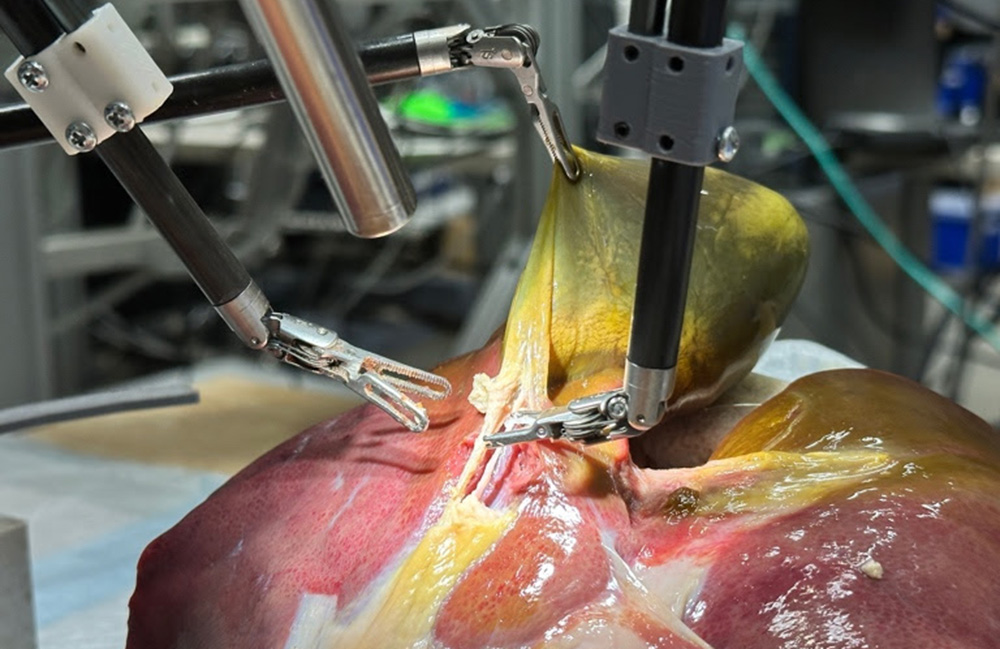
The Surgical Robot Transformer-Hierarchy performing a gallbladder surgery. | Source: Juo-Tung Chen, Johns Hopkins University
Johns Hopkins University today announced that a robot trained on videos of surgeries performed a lengthy phase of a gallbladder removal without human help. The robot operated for the first time on a lifelike patient. During the operation, it responded to and learned from voice commands from the team, like a novice surgeon working with a mentor.
The robot performed with the expertise of a skilled human surgeon across the trials, even during unexpected scenarios typical in real-life medical emergencies, according to the researchers. The federally funded work marks an advancement in surgical robotics, where robots can perform with both mechanical precision and human-like adaptability and understanding, said Johns Hopkins.
“This advancement moves us from robots that can execute specific surgical tasks to robots that truly understand surgical procedures,” stated medical roboticist Axel Krieger. “This is a critical distinction that brings us significantly closer to clinically viable autonomous surgical systems that can work in the messy, unpredictable reality of actual patient care.”
Johns Hopkins system adapts to anatomy in real time
In 2022, Krieger’s Smart Tissue Autonomous Robot, STAR, performed its first autonomous robotic surgery on a live animal – a laparoscopic surgery on a pig. But that robot required specially marked tissue, operated in a highly controlled environment, and followed a rigid, predetermined surgical plan. Krieger said it was like teaching a robot to drive along a carefully mapped route.
But he said the new system “is like teaching a robot to navigate any road, in any condition, responding intelligently to whatever it encounters.”
Surgical Robot Transformer-Hierarchy, SRT-H, truly performs surgery, he said. It can adapt to individual anatomical features in real time, make decisions on the fly and self-correct when things don’t go as expected.
Built with the same machine learning architecture that powers ChatGPT, SRT-H is also interactive, able to respond to spoken commands (such as “grab the gallbladder head”) and corrections (“move the left arm a bit to the left”). The robot learns from this feedback.
“This work represents a major leap from prior efforts because it tackles some of the fundamental barriers to deploying autonomous surgical robots in the real world,” said lead author Ji Woong “Brian” Kim, a former postdoctoral researcher at Johns Hopkins who’s now at Stanford University. “Our work shows that AI models can be made reliable enough for surgical autonomy—something that once felt far-off but is now demonstrably viable.”
SRT-H builds on basic surgical tasks
Last year, Krieger’s team used the system to train a robot to perform three foundational surgical tasks: manipulating a needle, lifting body tissue, and suturing. Those tasks took just a few seconds each. Johns Hopkins won a 2025 RBR50 Robotics Innovation Award for the achievement.
The gallbladder-removal procedure is much more complex, a minutes-long string of 17 tasks. The robot had to identify certain ducts and arteries and grab them precisely, strategically place clips, and sever parts with scissors.
SRT-H learned how to do gallbladder work by watching videos of university surgeons doing it on pig cadavers. The team reinforced the visual training with captions describing the tasks.
After watching the videos, the robot performed the surgery with 100% accuracy, according to Johns Hopkins. Although the robot took longer to perform the work than a human surgeon, the results were comparable with those from an expert surgeon.
“Just as surgical residents often master different parts of an operation at different rates, this work illustrates the promise of developing autonomous robotic systems in a similarly modular and progressive manner,” said Jeff Jopling, a co-author and Johns Hopkins surgeon.
The robot performed across anatomical conditions that weren’t uniform, and during unexpected detours. Including when the researchers changed the system’s starting position and when they added blood-like dyes that changed the appearance of the gallbladder and surrounding tissues.
“To me, it really shows that it’s possible to perform complex surgical procedures autonomously,” Krieger said. “This is a proof of concept that it’s possible and this imitation learning framework can automate such complex procedure with such a high degree of robustness.”
The team said it would like to train and test the system on more types of surgeries and expand its capabilities to perform a complete autonomous surgery.
The post Johns Hopkins teaches robot to perform a gallbladder removal on a realistic patient appeared first on The Robot Report.

